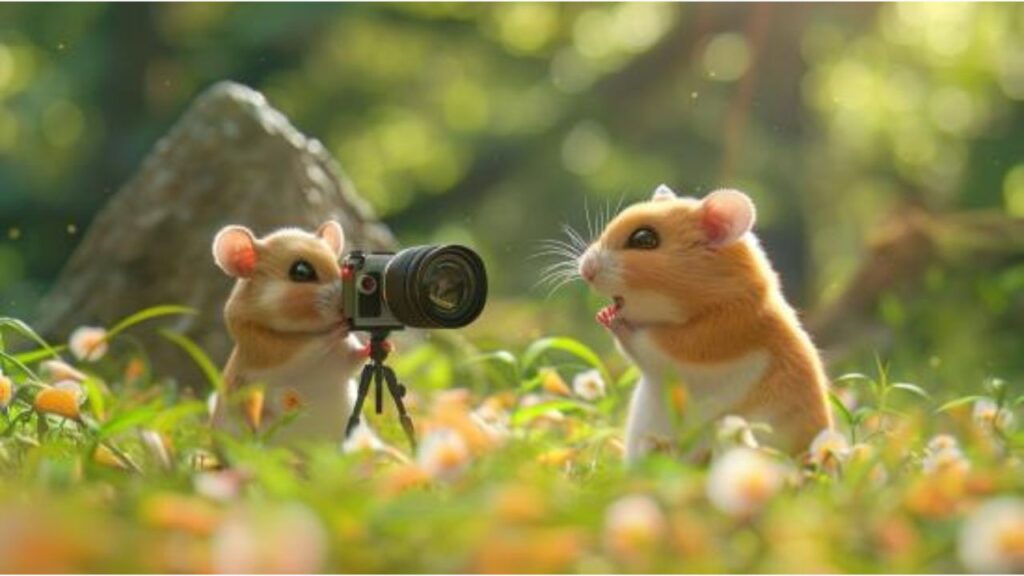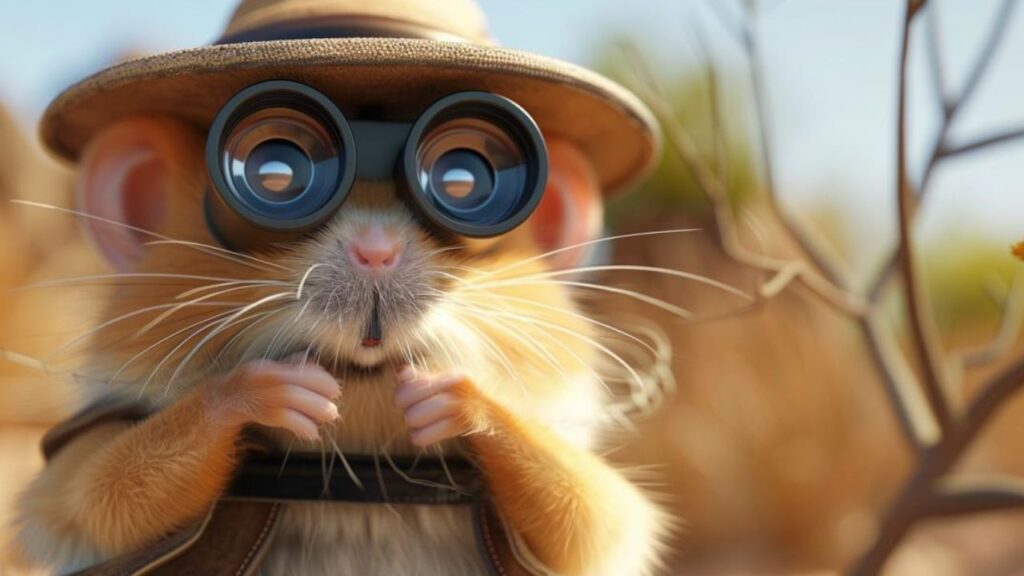In the bustling world of pet care, curiosity often leads us down interesting paths. One such path in the realm of hamster enthusiasts is the thought of hamster cohabitation. The enchanting idea of different hamster breeds living side by side, much like a miniaturized United Nations of hamsters, captures many imaginations. Picture a Syrian hamster sharing a meal with a Roborovski or a Campbell’s dwarf playing chase with a Chinese hamster. The scenarios are as delightful as they are diverse.
But as with many aspects of pet care, fantasy and reality are two distinct realms. This article aims to delve deep into the prospects, challenges, and genuine concerns surrounding the idea of housing various hamster breeds together. By understanding the intricacies of their behavior and their inherent needs, we can make informed decisions for our tiny furballs, ensuring their happiness and well-being.
Hamster Cohabitation: A Trend or a Trap?
In recent years, the trend of multi-species households (not just limited to hamsters) has seen a surge. Pictures of cats cuddling with birds or dogs playing with rabbits often go viral, painting an idyllic picture of interspecies friendships. But when it comes to hamsters, particularly of different breeds, can such cohabitation be more of a trap than a harmonious living arrangement? As we journey through this article, we will unravel the mysteries of hamster social dynamics, backed by science, observations, and the collective experiences of hamster caregivers worldwide.
Understanding Hamster Breeds and Their Natural Behaviors

When we bring these small, furry creatures into our homes, there’s an underlying curiosity about their behavior, especially in terms of their sociability. Can they coexist with others of their kind, or perhaps, with different breeds altogether? It’s a fascinating question and one that dives deep into the natural inclinations and behaviors of different hamster breeds. Before jumping into the intricate world of hamster cohabitation, it’s essential to first understand the distinct breeds and their innate behaviors, which have evolved over centuries in diverse environments.
Species Overview
Hamsters, though small in stature, come with a diversity that might surprise many. Primarily, there are five breeds that are most commonly kept as pets:
- Syrian Hamsters: Also known as the golden hamster, they are among the largest of the pet hamster breeds and are known for their golden-brown coat, though many color variations exist.
- Roborovski Hamsters: Recognized by their rapid movements and tiny size, these hamsters are often a delight to watch but can be a challenge to handle due to their swift nature.
- Campbell’s Dwarf Hamsters: Originating from Mongolia and Northeast China, they have a close resemblance to the winter white but have distinctive differences in coat color and patterns.
- Winter White Russian Dwarf Hamsters: They have a unique ability to change their coat color in winter, turning almost entirely white.
- Chinese Hamsters: With a more elongated body compared to other breeds, they are sometimes mistaken for tiny rats or mice.
Each of these breeds, while sharing the hamster moniker, has evolved in different environments and has developed distinct behaviors and social structures.
Natural Tendencies Towards Cohabitation or Solitude
In nature, hamsters have shown a mixed bag of social tendencies. Understanding these can provide valuable insights into their behavior in domestic settings:
- Syrian Hamsters: Naturally solitary, adult Syrians can become territorial and may fight with other hamsters, especially of the same sex. In the wild, they live and forage alone, coming together primarily for mating purposes.
- Roborovski and Dwarf Hamsters: These breeds are more sociable and can sometimes live in pairs or small groups in the wild. However, this doesn’t mean they always prefer company. Captivity can sometimes alter these dynamics, leading to unexpected conflicts.
- Chinese Hamsters: They have a somewhat middle-ground behavior. In some settings, they can be solitary, while in others, they might coexist with minimal conflicts.
It’s crucial to understand that while these are general behaviors observed in the wild, individual hamsters have unique personalities. Factors like upbringing, environment, and past experiences can greatly influence their behavior towards other hamsters, even within the same breed.
In terms of hamster cohabitation, the idea isn’t as simple as just knowing the breeds. It’s about recognizing the individual temperaments and the inherent risks and benefits associated with trying to house different breeds—or even same breeds—together.
The Risks of Mixing Breeds

The desire to create a diverse and vibrant hamster community by mixing different breeds is an alluring one for many pet enthusiasts. However, before we dive into a multi-breed habitat, it’s imperative to have a comprehensive understanding of the risks involved. While images of multiple hamster breeds living harmoniously might populate social media, the actual challenges of such cohabitation can be vast and, in some cases, detrimental to the hamsters’ well-being.
Territorial Disputes
Every hamster species has its unique behavioral traits, many of which are hardwired from their days in the wild. Territories are sacred for these little creatures. Defining and defending their territory ensures their survival by giving them unhindered access to food and a safe space away from potential threats.
When you introduce different breeds into a single environment, the likelihood of territorial disputes intensifies. Each breed might interpret the other’s behavior as an infringement on its territory, leading to confrontations. While some confrontations might appear minor, like a brief chase or a push, others can escalate to aggressive fights that result in injuries or even fatalities.
Syrian hamsters, often adored for their fluffy coats and endearing personalities, exemplify this territorial nature. They are particularly known for their solitary preference, and housing them with another breed can lead to extremely aggressive behaviors. It’s not just about fights; the constant stress from territorial disputes can reduce their lifespan and overall quality of life.
Health Implications
A harmonious hamster habitat is not just about preventing physical disputes; it’s also about ensuring the health of each resident. Different hamster breeds might carry distinct diseases or health issues that another breed isn’t naturally exposed to in the wild. By mixing breeds, you inadvertently increase the risk of cross-exposure to these illnesses.
Moreover, the continuous stress from potential confrontations, even if they don’t escalate to physical altercations, can have severe health implications. A stressed hamster might experience a suppressed immune system, increasing its vulnerability to diseases. Chronic stress can also manifest in behaviors like over-grooming, leading to fur loss, skin infections, and other related health problems. Observing such signs becomes even more crucial when breeds are mixed, as they may be indicative of deeper underlying issues.
Breeding Concerns
When discussing the idea of housing multiple hamster breeds together, the topic of breeding inevitably emerges. Some breeds might be genetically incompatible for interbreeding, but accidental mating occurrences aren’t rare. Such unplanned pregnancies can lead to complications for the mother and offspring, from difficult pregnancies to health issues in the young.
Furthermore, crossbreeding might produce offspring that carry the traits of both breeds. This can sometimes result in hamsters that aren’t easily identifiable as a specific breed, complicating their care requirements. Additionally, the surge in unplanned litters presents an ethical dilemma: finding suitable homes for these hamsters, ensuring they receive proper care, and preventing further unplanned breeding.
The world of hamster cohabitation is filled with complexities that go beyond mere compatibility. To provide the best life for these delightful creatures, a thorough understanding of their needs, behaviors, and potential risks is indispensable.
When Cohabitation Works: Exceptions to the Rule

The broad spectrum of hamster cohabitation paints a picture dominated by challenges, risks, and potential pitfalls. However, in the realm of these tiny, whiskered creatures, exceptions exist. There are certain circumstances under which cohabitation might not just be possible, but also beneficial for the hamsters involved. Navigating these exceptions requires a delicate balance of understanding, careful observation, and adherence to specific conditions.
Same-Species Pairs or Groups
While mixing different breeds is fraught with complications, housing hamsters of the same species together can sometimes yield positive results. For instance:
- Dwarf Hamsters: Some varieties of dwarf hamsters, such as the Campbell’s dwarf or Winter White, often fare well when living with littermates or hamsters they’ve known from a young age. Their sociable nature in the wild translates into a more tolerant attitude towards cohabitation under domestic settings. However, it’s vital to monitor their interactions frequently, as disputes can still arise, particularly during their adolescence or breeding seasons.
- Roborovski Hamsters: Renowned for their rapid, darting movements and tiny statures, Roborovskis are generally peaceable when living with same-species companions. They thrive in familiar company, often cuddling up together or partaking in synchronized activities. But as with all species, it’s crucial to provide ample space and resources to minimize potential conflicts.
It’s essential to note that while some hamster species might exhibit higher tolerance levels towards their kind, the universally solitary Syrian hamster remains an exception. Housing two Syrians together, regardless of their familiarity, is a recipe for severe conflicts.
Necessary Conditions for Successful Cohabitation
Even when dealing with hamster species that have a natural inclination towards social living, ensuring the right conditions is paramount for cohabitation success:
- Spacious Enclosure: Providing ample space is non-negotiable. Each hamster should have enough room to establish its territory, access resources without competition, and have personal hideouts. Overcrowding can lead to increased stress and confrontations.
- Multiple Resources: Ensure there are multiple food dishes, water bottles, and hideouts. This reduces competition and ensures every hamster can access necessities without encroaching on another’s territory.
- Neutral Introduction Ground: If introducing unfamiliar hamsters, doing so on neutral ground can reduce territorial instincts. A brief period in a neutral playpen can help them get acquainted without the pressures of established territories.
- Regular Monitoring: Even in seemingly harmonious setups, it’s essential to monitor interactions regularly. Look out for signs of bullying, such as one hamster always chasing another away from resources, or subtle signs of stress like over-grooming.
In conclusion, while the general consensus leans towards caution in hamster cohabitation, exceptions do exist. By understanding specific species behaviors and ensuring optimal conditions, hamster owners can sometimes create a successful shared habitat. But always prioritize the safety and well-being of these tiny creatures above any personal desires for a multi-hamster setup.
Key Considerations Before Mixing Species

The decision to house different hamster species together should never be made lightly. Even with the potential for exceptions, risks remain prevalent. For those who are considering this venture, being well-informed and prepared is crucial. The harmony of a mixed-species hamster habitat relies not just on understanding hamster behavior, but also on meticulous planning and proactive monitoring.
Proper Introduction Techniques
Introducing hamsters to one another, especially of different breeds, requires patience and strategic planning:
- Neutral Territory: Begin introductions in a neutral area where neither hamster has established a territory, such as a clean playpen. This minimizes territorial aggression and allows the hamsters to approach each other without the added stress of defending their home.
- Short and Supervised Sessions: The initial meetings should be brief, perhaps only a few minutes, and always under close observation. Gradually increase the duration of these sessions over several days, always ending on a positive note.
- Scent Familiarization: Before letting hamsters meet face-to-face, consider swapping their bedding or toys. This helps them get accustomed to each other’s scent, which can reduce the novelty and potential aggression during their first direct interaction.
Monitoring Interactions
Once the hamsters share the same living space, it’s essential to remain vigilant:
- Look for Subtle Signs: While outright aggression is a clear indicator of problems, other subtler signs like avoidance behaviors, excessive grooming, or one hamster always hogging resources can indicate underlying stress or bullying.
- Daily Check-ins: It’s crucial to observe your hamsters daily, ideally during their most active periods, to ensure that they are coexisting peacefully.
- Establish Multiple Resource Points: To minimize competition and potential disputes, ensure there are several food dishes, water sources, and hideouts spread throughout the cage.
Escape and Separation Planning
Despite the best efforts, things might not always go smoothly:
- Immediate Separation: At the first sign of severe aggression, separate the hamsters immediately. A single intense fight can result in severe injuries or even fatalities.
- Plan B Housing: Always have an additional cage or habitat ready. If you notice persistent conflicts or one hamster showing signs of extreme stress, you must have the means to separate them quickly and permanently.
- Escape-Proofing: Given the heightened tensions in mixed-species enclosures, ensure the habitat is escape-proof. A stressed hamster might attempt to flee, leading to potential dangers outside their cage.
In essence, while mixing hamster species can be a fascinating endeavor, it’s laden with potential pitfalls. Adhering to these considerations and always prioritizing the well-being of your pets will go a long way in ensuring their safety and happiness.
The Safe Approach to Hamster Companionship

Hamster enthusiasts often gravitate toward the idea of creating a bustling community within a cage, imagining various breeds interacting harmoniously. However, as highlighted, mixed-species cohabitation can present significant challenges and risks. Instead, there are safer approaches to fostering hamster companionship that ensure both their physical and psychological well-being.
Alternatives to Housing Different Breeds Together
While the allure of a multi-breed habitat can be tempting, there are alternative setups that can offer both safety and entertainment:
- Separate but Adjacent Enclosures: If space allows, consider placing separate enclosures side by side. This allows hamsters to be aware of each other’s presence, potentially offering some stimulation without the risks of direct contact.
- Interactive Toys and Environments: Rather than seeking stimulation from other hamster breeds, invest in a variety of toys and habitat enrichments. Tunnels, wheels, climbing structures, and foraging toys can keep a hamster engaged and satisfied.
- Regular Playtime Outside the Cage: Providing a safe playpen or supervised exploration time outside the cage can give hamsters a change of scenery and new environments to investigate, reducing the perceived need for a companion.
Benefits of Single-Breed Enclosures
Opting for single-breed or even single-hamster habitats come with several advantages:
- Reduced Stress: Without the need to navigate inter-species dynamics or compete with different breeds, hamsters can enjoy a more relaxed environment, conducive to their natural behaviors.
- Tailored Environments: Different hamster breeds have specific needs. A single-breed enclosure allows for a setup tailored precisely to that breed’s preferences, from bedding depth to the types of toys and structures.
- Easier Monitoring: Without multiple breeds to watch over, it becomes more straightforward to observe and ensure the well-being of your hamster. Behavioral changes, potential illnesses, or dietary habits can be more easily noticed and addressed.
- No Breeding Concerns: Especially in mixed-gender setups, there’s always a risk of unplanned litters. By keeping a single breed and being mindful of genders, this risk can be significantly mitigated.
In conclusion, while the idea of a diverse hamster community might seem appealing, the practical and ethical implications often suggest a more cautious approach. Prioritizing the well-being and happiness of your pets will always lead to a more fulfilling hamster-keeping experience.
Conclusion

Hamsters, with their varied personalities, colors, and sizes, captivate the hearts of many pet lovers. The thought of creating a miniature society within a cage, where different breeds coexist harmoniously, might seem like an enchanting idea. Yet, as this exploration into hamster cohabitation has revealed, such setups come with numerous challenges and potential pitfalls.
A Balanced Perspective on the Subject
It’s essential to approach the subject of hamster cohabitation with a balanced viewpoint. While there are instances where same-species pairs or groups can thrive together under the right conditions, the risks associated with mixing breeds often outweigh the benefits. Each hamster breed has evolved with specific behavioral traits and social structures. These natural tendencies play a significant role in determining whether cohabitation is feasible or fraught with danger.
Encouraging Informed and Safe Decisions for Hamster Care
The well-being of our furry friends should always be the top priority. Making decisions based on thorough research, expert advice, and a deep understanding of individual hamster needs is crucial. By doing so, we not only ensure the health and happiness of our pets but also enrich our experience as hamster caregivers.
In the journey of hamster keeping, it’s always better to err on the side of caution. Opting for setups that prioritize safety and comfort, even if it means keeping breeds separate, will ultimately lead to a more harmonious and fulfilling relationship with these delightful creatures.




